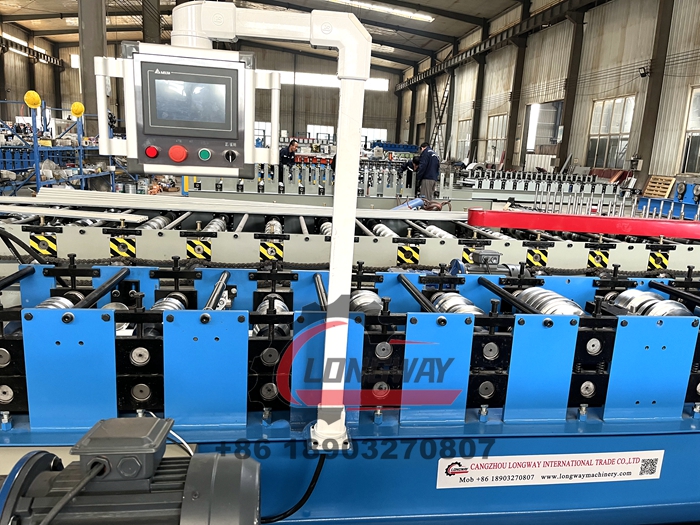roll forming machine for steel
Roll Forming Machine for Steel An Overview
Roll forming is a manufacturing process used to create specific cross-sectional shapes from metal sheets or strips. The roll forming machine is designed to perform this process efficiently, ensuring high precision and productivity. Steel, due to its strength and versatility, is one of the most commonly used materials in roll forming applications. This article explores the functioning, advantages, applications, and future prospects of roll forming machines for steel.
Functioning of Roll Forming Machines
The roll forming process begins with feeding a flat strip of steel into the roll forming machine. The machine comprises a series of rollers arranged in a specific sequence. Each roller gradually shapes the steel strip into the desired cross-section as it passes through the rollers. The process can be continuous, allowing for long lengths of material to be formed, which is especially beneficial for applications requiring long parts.
The initial setup involves designing a precise roller profile that will shape the steel accurately. Computer-aided design (CAD) software is often used to create these profiles, ensuring that the end product meets specific dimensional tolerances. Once the rollers are shaped, the steel strip is fed into the machine, typically using automated systems for efficiency. The speed at which the steel is fed and the number of rollers involved can be adjusted to optimize production rates.
Advantages of Roll Forming Machines
Roll forming machines offer several significant advantages over other metal forming processes. One of the primary benefits is their ability to produce highly uniform and consistent parts. The continuous nature of the process minimizes waste and improves overall efficiency since the same machine can produce a wide variety of shapes with minimal downtime.
Another advantage is the ability to handle various steel grades and thicknesses. Roll forming machines can work with cold-rolled, hot-rolled, galvanized, and even pre-painted steel, allowing manufacturers to meet diverse customer requirements. Additionally, the process produces products with excellent surface finishes, reducing the need for secondary operations like machining or grinding.
roll forming machine for steel

The durability and strength of steel make it an ideal material for roll-formed products, particularly in construction and structural applications. Components such as steel studs, tracks, roof panels, and wall sections benefit from the inherent strength of steel, making roll forming an invaluable technique in manufacturing robust building materials.
Applications of Roll Forming
Roll forming machines are extensively used across various industries. In construction, they are employed to create structural components, roofing profiles, and curtain wall framing systems. In the automotive sector, roll-formed steel can be found in brackets, chassis components, and reinforcements due to its ability to provide high strength-to-weight ratios.
Moreover, roll forming is critical in the production of electrical enclosures, HVAC ducting, and furniture frames, showcasing its versatility. The technology is not stagnant; continuous innovations in the field, such as automated setups and integration with artificial intelligence, are enhancing the capabilities and efficiency of roll forming machines.
Future Prospects
The future of roll forming machines for steel seems promising. With the growing demand for energy-efficient buildings and sustainable construction practices, roll forming technology will likely evolve to meet these needs. Innovations such as lightweight materials, improved automation, and the integration of smart technology will further enhance the efficiency and capability of these machines.
As the construction and automotive industries continue to evolve, the role of roll forming machines will be crucial in adapting to new design challenges and regulatory requirements. By embracing new technologies and processes, manufacturers can capitalize on the advantages that roll forming offers, ensuring that they remain competitive in an ever-changing market.
In conclusion, roll forming machines play a vital role in the efficient, precise production of steel components. With their numerous advantages and diverse applications, these machines are indispensable in modern manufacturing, and their future looks bright as technology continues to advance.
-
Key Features to Look for in a Roof and Wall Panel MachineNewsMay.23, 2025
-
Key Features of a Roller Shutter Door Forming MachineNewsMay.23, 2025
-
Key Features of a Purlin Roll Forming MachineNewsMay.23, 2025
-
Key Features of a Cut to Length & Slitting LineNewsMay.23, 2025
-
Benefits of Using a Downspout Gutter Forming MachineNewsMay.23, 2025
-
Advantages of Using a Steel Deck Floor Roll Forming MachineNewsMay.23, 2025
-
Revolutionize Your Gutter Production with a Gutter MachineNewsMay.23, 2025








